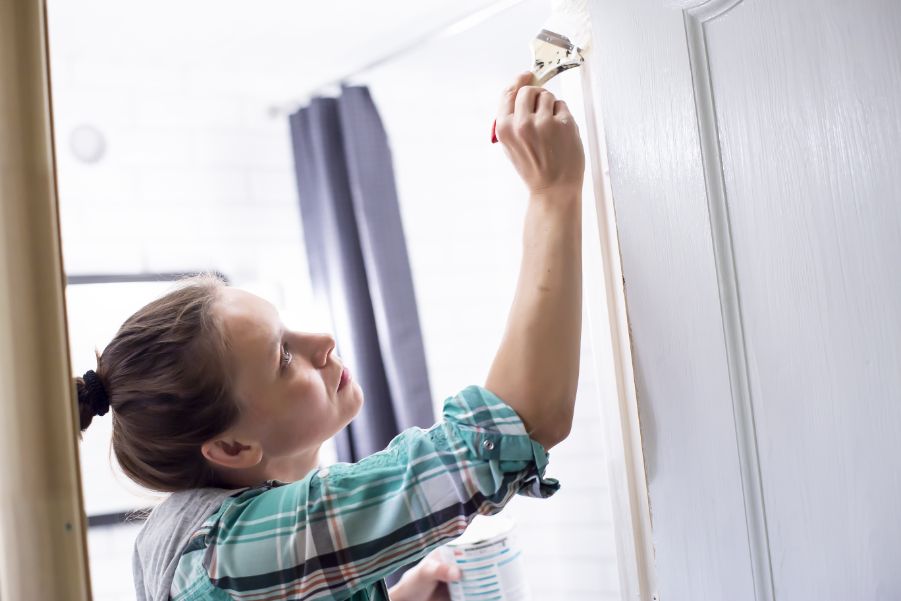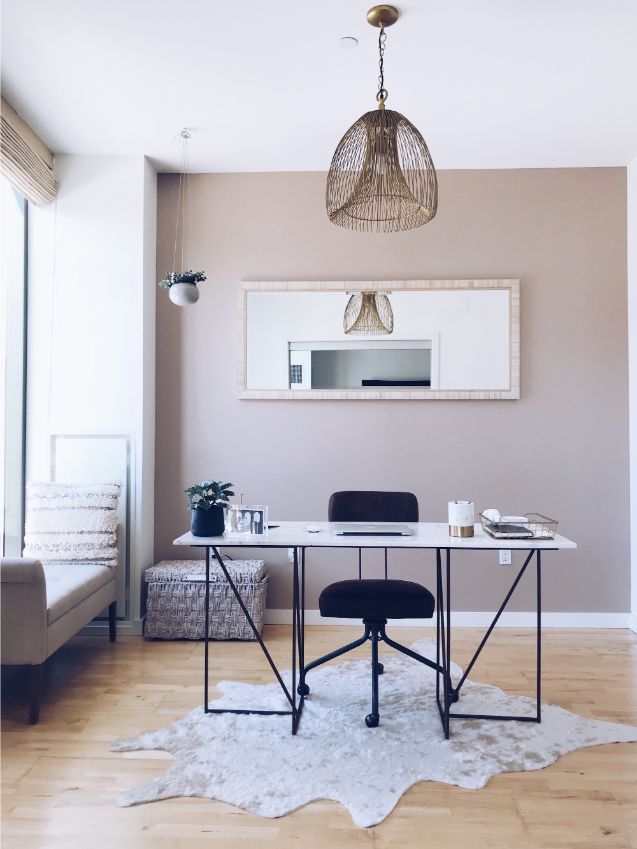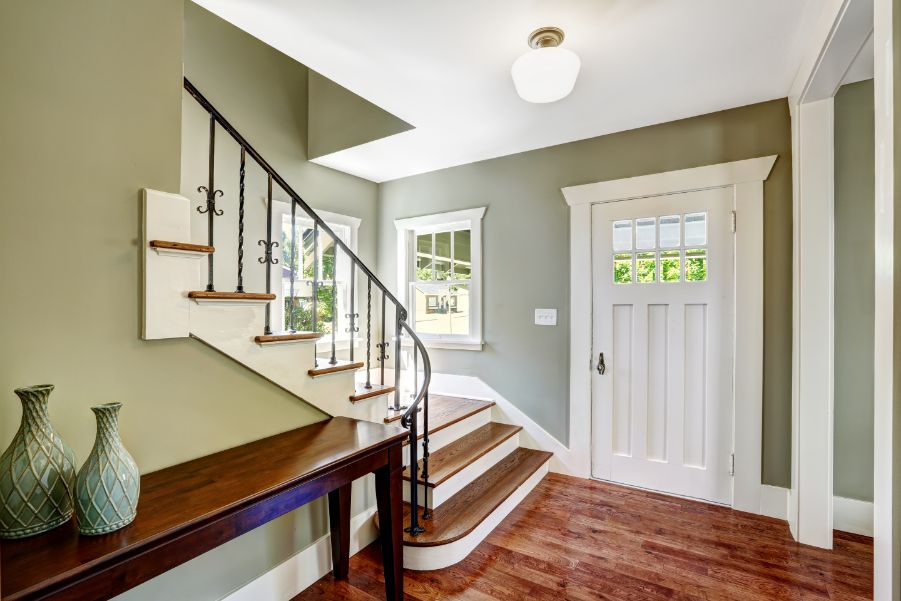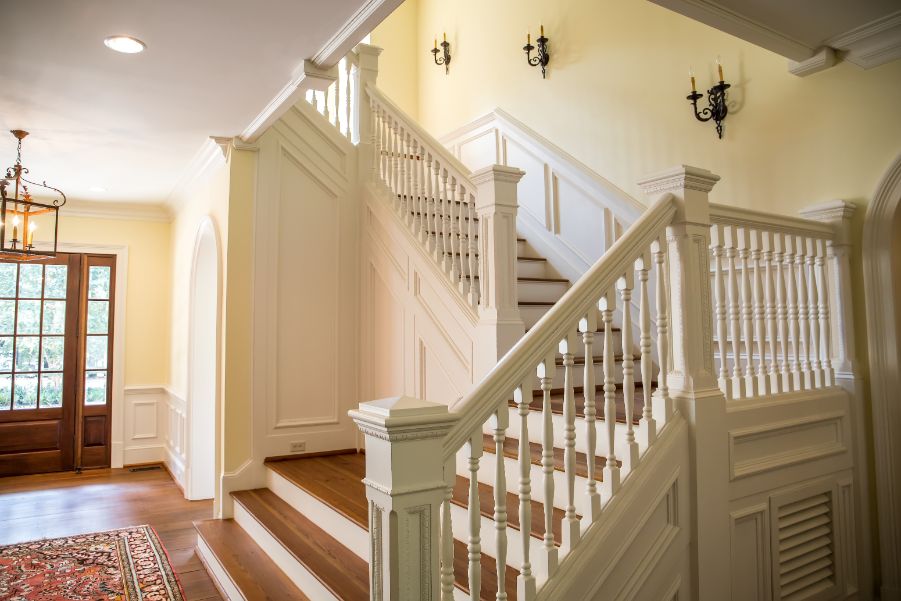Pro Tips for Painting Interior Doors

If you’re looking to give your interior doors an update, a fresh coat of paint can do wonders, as doors can be one the first places to show wear and tear. New interior door paint can give your space a visual boost. If you’re wondering how to create a professional-looking paint job, our pros share tips to get the best results below.
Tools and Materials for Your Interior Door Paint Job
Before you begin painting doors, it’s essential to have the necessary tools to help you prep, prime and paint the door.
Must-have materials:
- Paint
- Paintbrush
- Sandpaper
- Four-inch rollers (foam works well) and a roller handle
- Mini roller tray
- Tack cloth (or microfiber cloth)
- Drop cloth (or cardboard box)
Nice-to-have materials:
- Wood filler
- Painters tape
- Utility knife
- Sawhorse
- Mask
Picking Your Paint Color
Selecting the paint can end up being the easiest — or most challenging part. A traditional white paint color will usually match the room’s trim. Or, a bold, dark color will make a statement. For example, painting the interior doors a dark color and carrying that same color through on the trim creates interest in a room without committing to all-over bold color.
Prep Your Interior Door Properly
The most important step of painting any surface is the prep work, and painting interior doors is no different. Below is a breakdown of the necessary steps to prep an interior door for fresh paint.
- Work area: Set up a designated painting area in your garage or covered outdoor space to provide ample work room and reduce interior mess. Using a sawhorse will make it easier to prep the door. Remember to lay down a drop cloth (or cardboard box) to catch drips.
- Prep work: Remove the door from the door hinges, as well as the doorknobs. If you decide to leave the door in place, tape the hinges and trace around the hinge with a utility knife to remove the excess tape.
- Repair flaws: Fill any holes, divots, or uneven sections of the door with wood filler to ensure the paint spreads evenly, then sand with 150-grit sandpaper until smooth. If the door was painted before 1980, test the old paint for lead before you begin sanding.
Sand and clean: Lightly sand the entire door with 220-grit sandpaper, dust with a cloth, then give it a final wipe down with a tack cloth to prepare it for priming.
To Prime or Not To Prime
Paint primer creates the foundation for a beautiful finished product. Primer reduces the number of paint coats you need and will help the paint last longer. In addition, primer helps the paint adhere better, covers imperfections on the wall and neutralizes the surface so the paint can show its true color. Priming is the key to creating a professional paint look even if you DIY. However, if you have new, pre-primed doors or you’re using latex paint on a door that’s already been painted with latex, you may not need to use a primer.
After you’ve primed your interior doors, sanding them one more time will help keep the surface smooth, flat and eliminate brush marks.
Oil-based primers are very versatile and work well with oil and latex paints. Oil-based primer is great on wood, metal and surfaces that have existing paint, and will also block surface stains. Latex primers are best for unfinished drywall. They are water-based and more flexible, which helps prevent peeling and cracks.
Paint Your Interior Doors Like A Pro
Whether you’re painting a flat or paneled door, use a combination of a brush and a roller for the best results. If your paint dries too quickly, you can consider using an additive that prevents the paint from drying too fast, like Floetrol.
Drying time depends on the type of paint you use. For example, latex paint dries faster than oil-based paint. Latex paint takes approximately one hour for the first coat to dry and about four hours until another coat can be applied. Oil-based paints take six to eight hours to dry and 24 hours until another coat can be applied. In addition, humidity and heat can impact drying times: high humidity slows down drying time, and high heat can speed up drying time. Proper ventilation will also help paint dry faster.
Some paint pros recommend wearing a mask when painting to reduce the risk of breathing in paint fumes and dust particles from sanding.
Tips for Painting a Flat Door
Below outlines the process for painting a flat door:
- Paint the edges: Starting with the inside edge (where the hinges are), paint the header and down the striker side (where the door bolt is). Use the brush around the striker for the best control, but don’t overload the brush.
- Paint the surface: Using a roller, apply two or three roller widths across and the full height of the door. Then brush from bottom to top with a brush or a lightly coated roller. This delivers the paint quickly and evenly to the door, leaving a wet edge and getting the smoothest finish.
Tips for Painting a Paneled Door
Below outlines the process for painting a paneled door:
- Paint the panels: Start with the upper left panel and work down the door in sequence. Paint the edges of the panels with a paintbrush, then fill in the panels with the roller.
- Paint the stiles: The stiles are the pieces between the panels. Start with the center vertical pieces, moving to the horizontal pieces. Finish the door with the two outer vertical stiles.
- Paint the edges: Paint the door’s edges in the same order as the flat door, fixing any drips or runs as you go.
Finishing the Door
Once the doors are prepped, primed and painted, it’s time for the finishing touches. Whether you’re painting flat or paneled interior doors, the finishing steps are the same. Below outlines the final stages of painting interior doors.
- Let the paint dry for the recommended amount of time.
- Lightly sand the doors to remove any brush marks or paint inconsistencies.
- Apply the second coat of paint.
- When the doors are dry, re-attach the hardware and rehang the doors.
If you’re ready for another painting project after painting your interior doors, we have paint project ideas for every space of your home. Contact us to order free paint swatch samples and learn more about our residential painting services.



